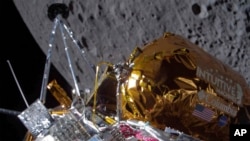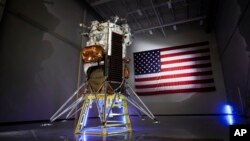Odysseus, the first U.S. spacecraft to land on the moon in more than 50 years — and the first from the private sector — was reported to be "alive and well" Friday but lying on its side.
Steve Altemus, CEO of Intuitive Machines, a Houston-based aerospace company that owns Odysseus, said the company thought the craft landed upright. But it was going too fast, either "caught a foot in the surface" or snapped one of its legs and fell onto its side, likely leaning on a rock. Two of its antennas are pointing down, which is limiting communication, he said.
"So far, we have quite a bit of operational capability even though we’re tipped over," he told reporters on Friday at a news conference in Houston.
Intuitive Machines was given $118 million for their expedition under NASA's Commercial Lunar Payload Services, or CLPS, initiative that seeks to bolster the lunar economy.
The spacecraft landed on the south polar region of the moon at 6:23 p.m. EST, near the Malapert A crater, close to the moon’s south pole. NASA's Lunar Reconnaissance Orbiter will try to pinpoint the lander's location this weekend.
For good news, five of NASA’s six payloads are on the exposed side of Odysseus as is one solar panel array, which is working, and the craft’s batteries are fully charged, Altemus told reporters.
In an earlier joint webcast, Intuitive Machines and NASA updated viewers on their expedition, saying they experienced issues with their navigation system, which caused them to take an extra lap around the moon to switch to NASA's laser navigation technology.
They also experienced a radio blackout during the voyage. When they reestablished connection to the spacecraft, the signal was weak.
Another issue that occurred was the failure to photograph the landing because of unforeseen complications.
A six-camera EagleCam system meant to capture the landing was intended to be launched by Embry-Riddle Aeronautical University, but according to a university spokesperson, "unexpected events" led them to change plans.
Rather than being deployed from the spacecraft to document the landing, the EagleCam was still attached to Odysseus when it landed.
Intuitive Machines CTO Tim Crain said, "Odie is a scrapper," on the X platform, referring to the spacecraft.
On Friday, the company said on X in their "Day One Update" that "we continue to learn more about the vehicle's specific information … overall health, and attitude [orientation]."
Despite the complications, NASA Administrator Bill Nelson called the landing a "triumph."
Last month, another spacecraft was sent to the moon by Astrobotic Technology under the CLPS program, but a fuel leak forced them to abort the mission and the lander crashed back to Earth.
Odysseus will operate for the next seven days on solar energy, transmitting lunar environmental data to Earth. That’s to prepare NASA for an upcoming space voyage this decade called "Artemis," in which NASA plans to send astronauts to the moon by 2026 at the earliest.
Some information for this report came from Reuters and The Associated Press.











